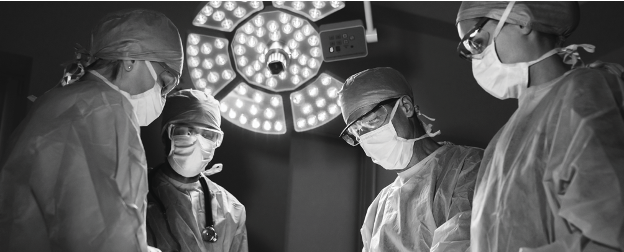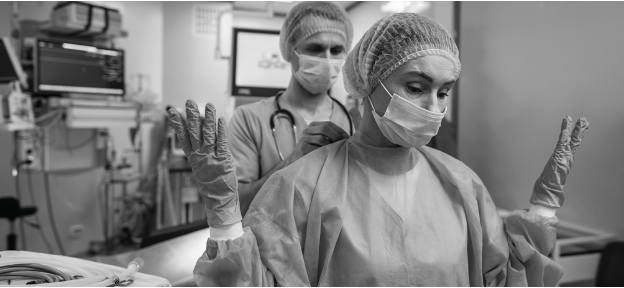Back to Articles
14 June 2024
The advent of off-pump methodology transformed the fundamentals of Coronary Artery Bypass Grafting (CABG) for cardiovascular surgeons worldwide. Those favoring Off-Pump CABG (OPCABG) over on-pump techniques underscore the distinct benefits of operating without cardiopulmonary bypass — namely, greater freedom of movement, shorter operating times, reduced systemic inflammation, and a lower risk of neurological, renal, and other vascular complications.1-3
However, OPCABG continues to receive persistent pushback from certain populations of the cardiology community. While several large retrospective studies and meta-analyses have unequivocally verified the safety and efficacy of OPCABG technique, there remain significant concerns regarding intra- and post-operative patient outcomes.4
Among the most prominent concerns, hemodynamic instability often takes the lead, as heart mobilization and coronary occlusion may lead to large hemodynamic variations and myocardial ischemias, respectively. The most common manipulation-related hemodynamic changes include a drop in cardiac output, decreased systemic arterial pressure, and increased pulmonary arterial pressure.5 These variations occur as a result of interrupted coronary blood flow during exposure and stabilization, as well as during the anastomosis procedure itself.
Reported hemodynamic changes in the left anterior descending artery after 15 minutes:5
Despite clear advantages over on-pump technique, the hemodynamic variability commonly seen in OPCABG may jeopardize coronary revascularization, which, in turn, threatens patient stability. Providers may take certain preventive measures to mitigate these changes, such as intra-aortic balloon pumps, perfusion pressure monitoring, and ischemic preconditioning, but on the whole, standard OPCABG methods may limit surgical efficiency and outcomes.4
A potentially serious by-product of hemodynamic fluctuations is incomplete revascularization, which is far more likely to occur in vessels that are relatively small, atherosclerotic, or located deep inside the myocardium.4 Off-pump is well-understood to play a direct role in impeding revascularization following CABG. One study evaluating off- pump left internal mammary artery (LIMA) grafting to the left anterior descending (LAD) artery found a 19.9% incomplete revascularization rate.6
As a result, OPCABG tends to necessitate more repeat revascularization procedures. A recent meta-analysis of several randomized controlled trials linked off-pump technique to a 1.9-fold increase in the risk for repeat revascularization within 30 days of surgery.7
In addition to another trip to the operating room, patients with incomplete revascularization following coronary surgery have a higher risk of major adverse cardiac or cerebrovascular events (MACCE). One multicenter randomized trial found that patients
with incomplete revascularization had a 33.5% greater chance of MACCE after three years
— largely attributable to the higher rate of repeat revascularization procedures.8
From disrupted hemodynamics to suboptimal revascularization, OPCABG technique is still in need of critical procedural improvements to ensure the best outcomes for CABG patients.

Overcoming the challenges of traditional OPCABG techniques requires technical innovations that minimize heart manipulation and pressure. The Enclose® II Proximal Anastomosis Assist Device offers an alternative method for off-pump procedures that lowers the risk of hemodynamic instability and postoperative complications while improving surgical outcomes.
The Enclose® II’s low-profile design was specifically built to obviate the need for partial aortic clamping. This sharply reduces pressure on vessel walls as well as potential tissue trauma, thereby lowering the risk of large hemodynamic fluctuations during the procedure. By operating with a more gentle technique, surgeons benefit from greater patient stability, which paves the way for more complete revascularization and long-term grafting success.

In addition to promoting hemodynamic stability, the Enclose® II also promotes secure graft construction. One study evaluating the Enclose® II’s efficacy during 222 proximal anastomoses found a 96.4% graft patency rate one year after surgery.9 This figure demonstrates the Enclose® II’s ability to consistently build higher-quality grafts than the standard clamping OPCABG technique. This has proven to be a significant challenge for surgeons; off-pump techniques typically fail to match the graft patency rate generated by on-pump techniques. One trial calculated a 94.1% patency rate for OPCABG, compared with the 98.1% rate for on-pump CABG.10
Furthermore, a clamp-free CABG technique enhances procedural safety by preventing plaque dislodgement. Steering clear of aortic manipulation keeps atherosclerotic plaque in place, thus minimizing the risk of systemic embolizations, primarily stroke and other cerebrovascular events. The previous study assessing the Enclose® II not only found no sign of aortic injury but also reported no plaque-related post-surgical complications.9
Equipped with an innovative, atraumatic, and low-profile design, the Enclose® II’s clampless anastomosis assist technique may become the gold standard for advancing OPCABG technique and improving patient outcomes.

By designing state-of-the-art and highly reliable surgical solutions, we are committed to best-in-class products to improve quality of care and accompany healthcare professionals in their daily practices.
Every healthcare provider, every partner, is different, and so are their needs. To be more reactive and closer to our partners and local customers, we have created local hubs in the Americas, France, Europe, the Middle East, Africa-India, and Asia-Pacific. With manufacturing facilities in key geographies: France, Germany, Algeria, India, and Thailand, we ensure the best standards in product quality, availability, and delivery.
Sources